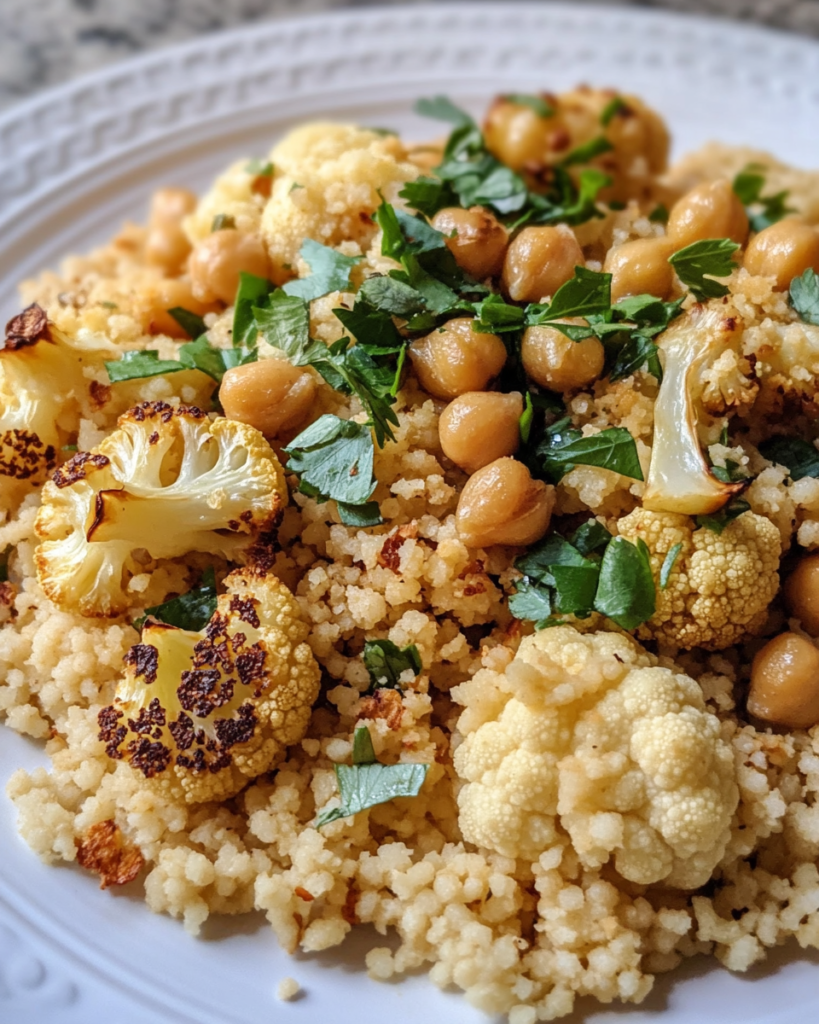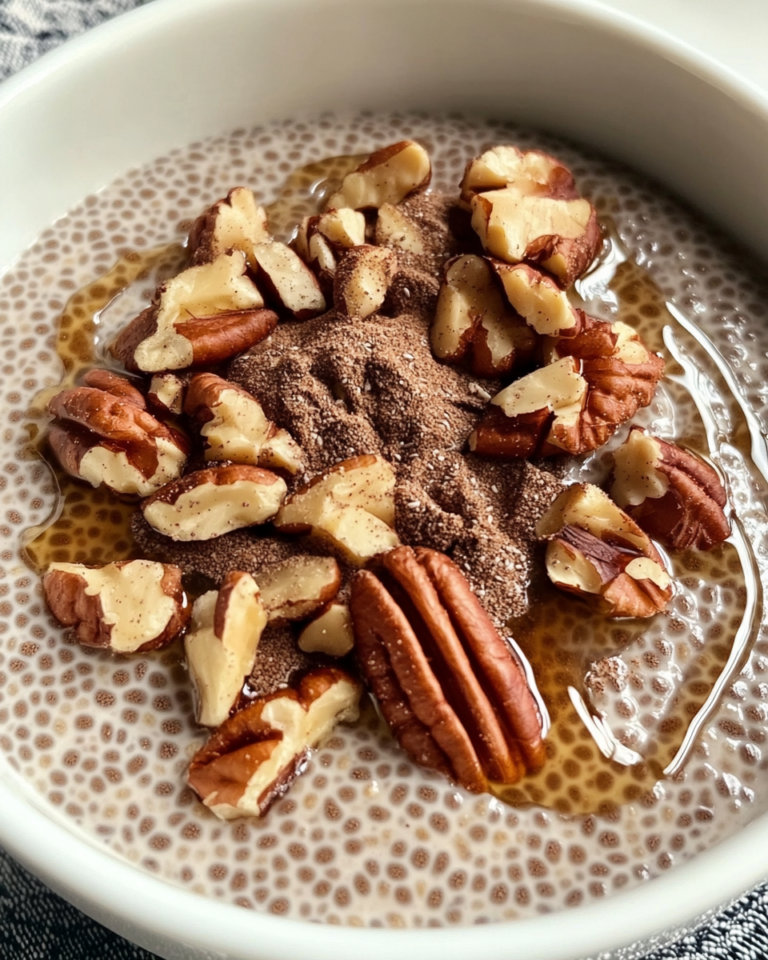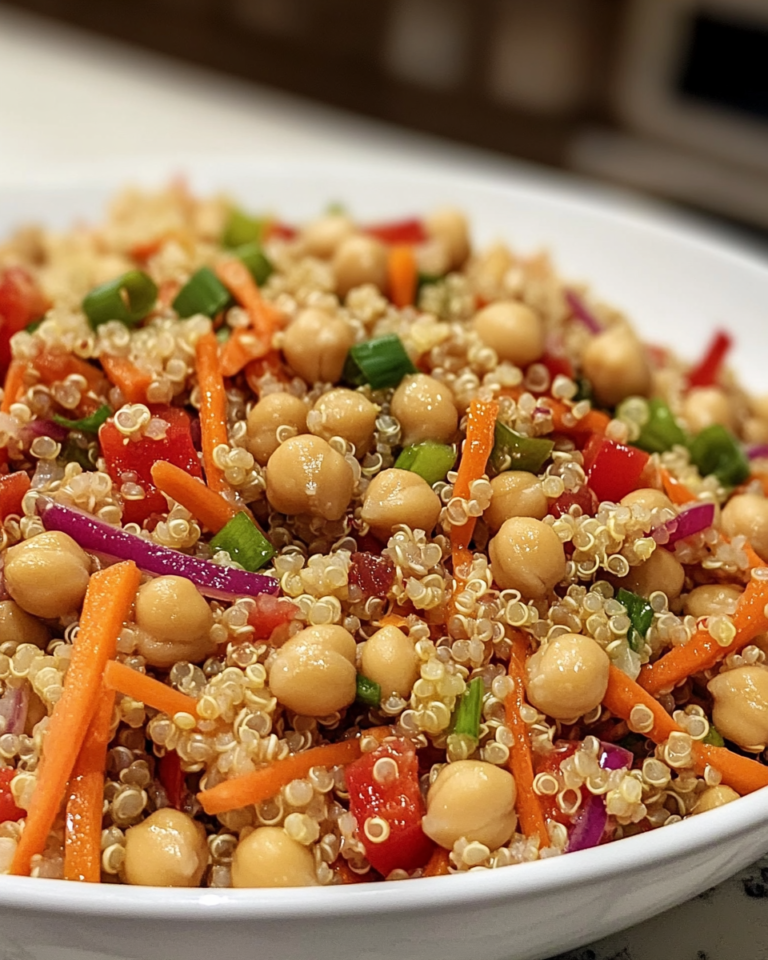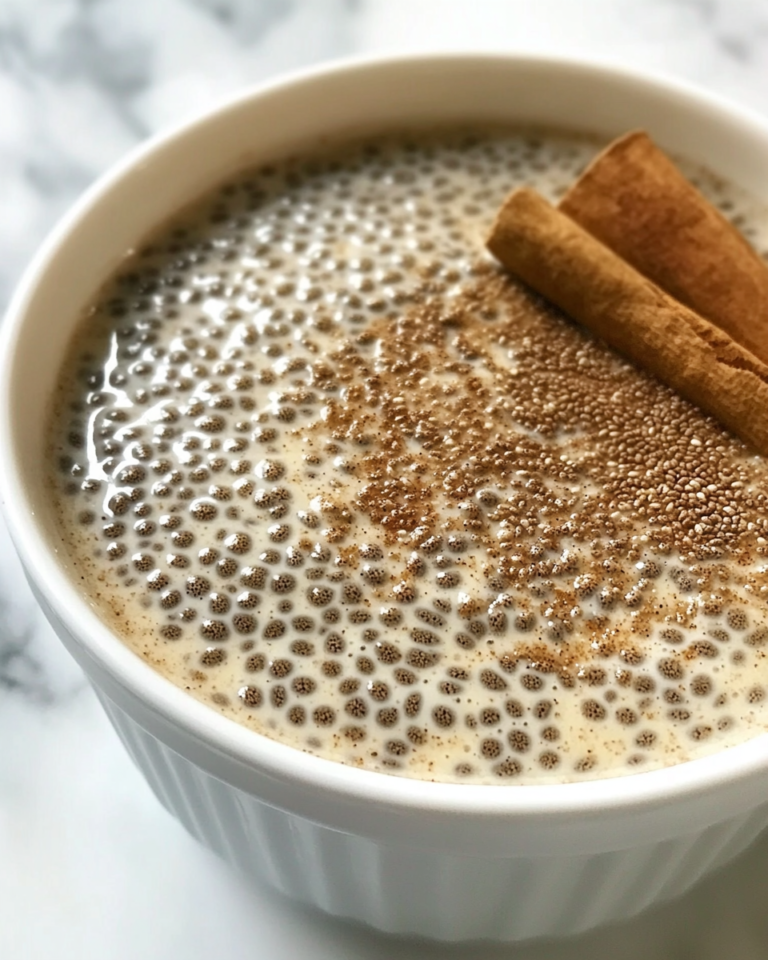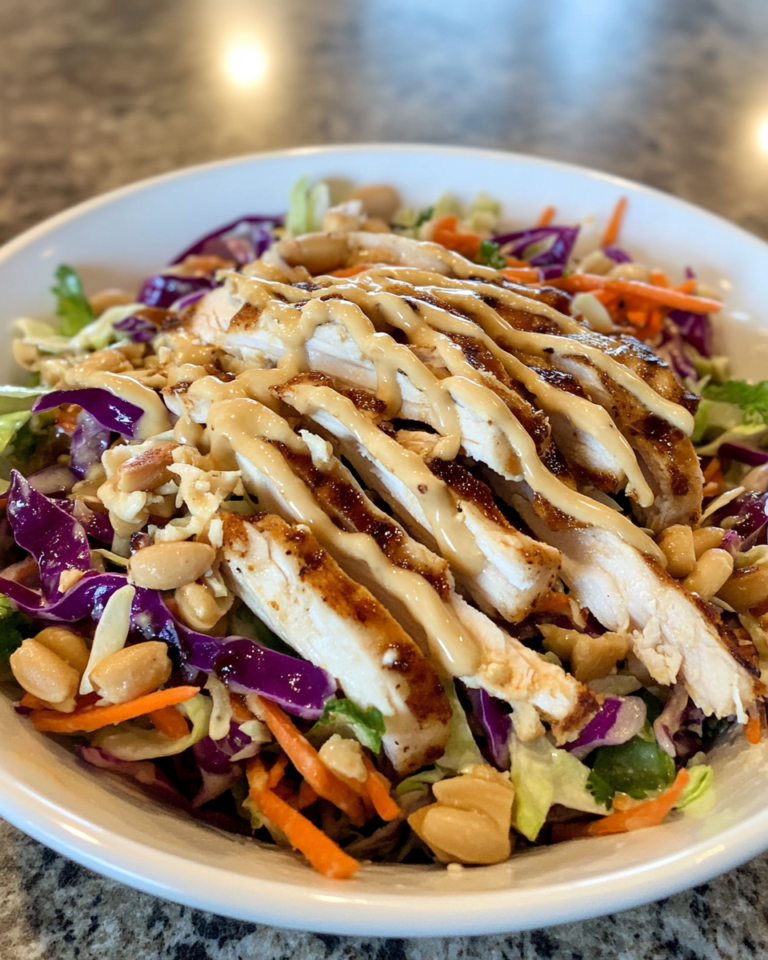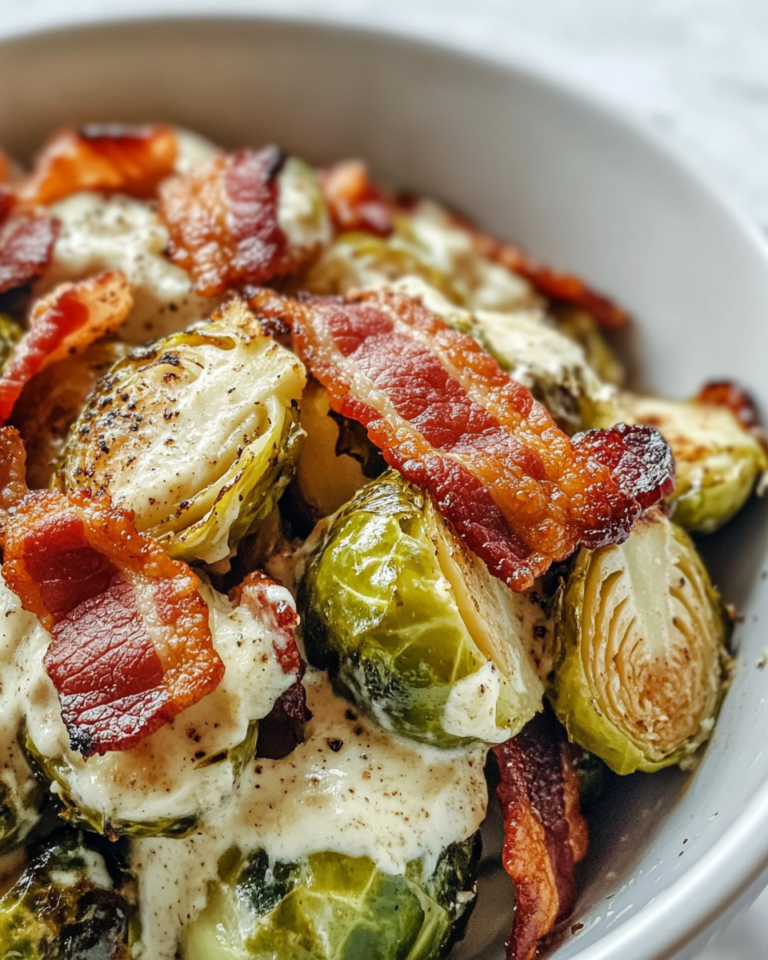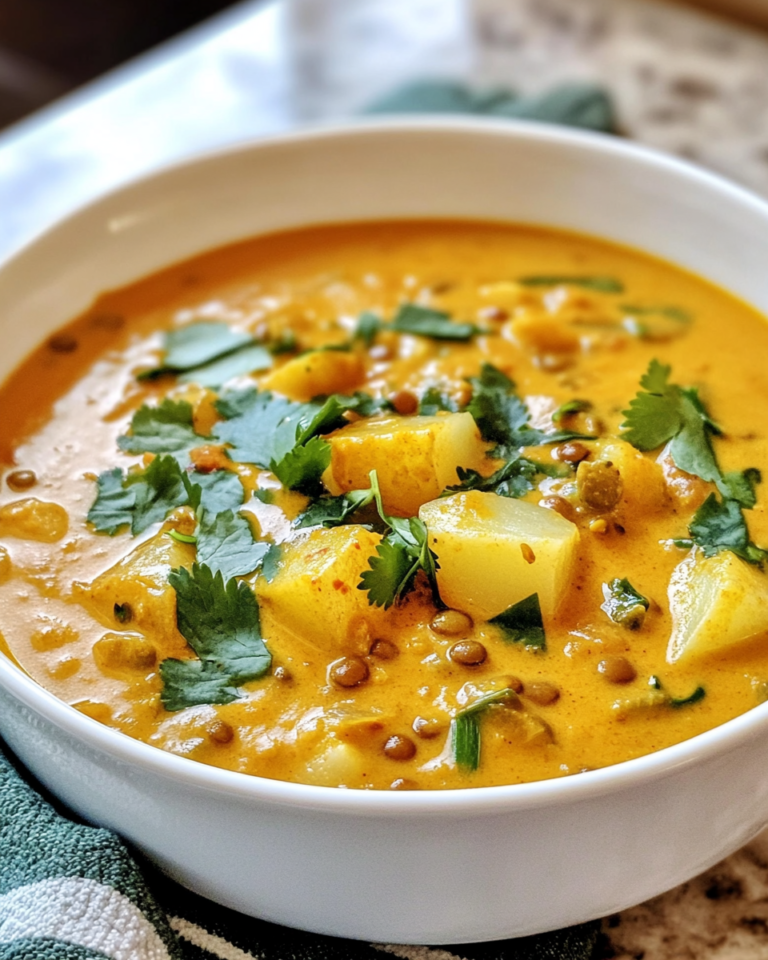Coconut Couscous with Roasted Cauliflower & Chickpeas
In a world where quick, nourishing, and delicious meals are always in demand, Coconut Couscous with Roasted Cauliflower & Chickpeas stands out as a true culinary gem. This dish blends warm, nutty couscous with the creaminess of coconut milk, roasted golden cauliflower, and spiced chickpeas, creating a hearty and satisfying plant-based option that doesn’t compromise on taste.
Whether you’re a seasoned vegan or simply trying to include more meatless meals in your routine, this recipe checks all the boxes: it’s easy to make, packed with flavor, and bursting with nutrition. Ready to spice up your dinner routine? Let’s dive into the full recipe!
Why Coconut Couscous?
Couscous is often underestimated. It’s light, fluffy, and absorbs flavors like a sponge. By cooking it in coconut milk, we elevate its creaminess and add a subtle sweetness that pairs beautifully with roasted vegetables and savory spices. It’s a perfect foundation for building a satisfying meal.
Ingredients List
Here’s everything you’ll need to bring this dish to life. These measurements serve 4 generous portions.
For the Roasted Cauliflower & Chickpeas:
- 1 medium head of cauliflower, cut into florets
- 1 can (15 oz) chickpeas, drained and rinsed
- 2 tablespoons olive oil
- 1 teaspoon ground cumin
- 1 teaspoon smoked paprika
- 1/2 teaspoon turmeric
- 1/2 teaspoon garlic powder
- 1/2 teaspoon salt
- 1/4 teaspoon black pepper
- Optional: pinch of cayenne pepper for heat
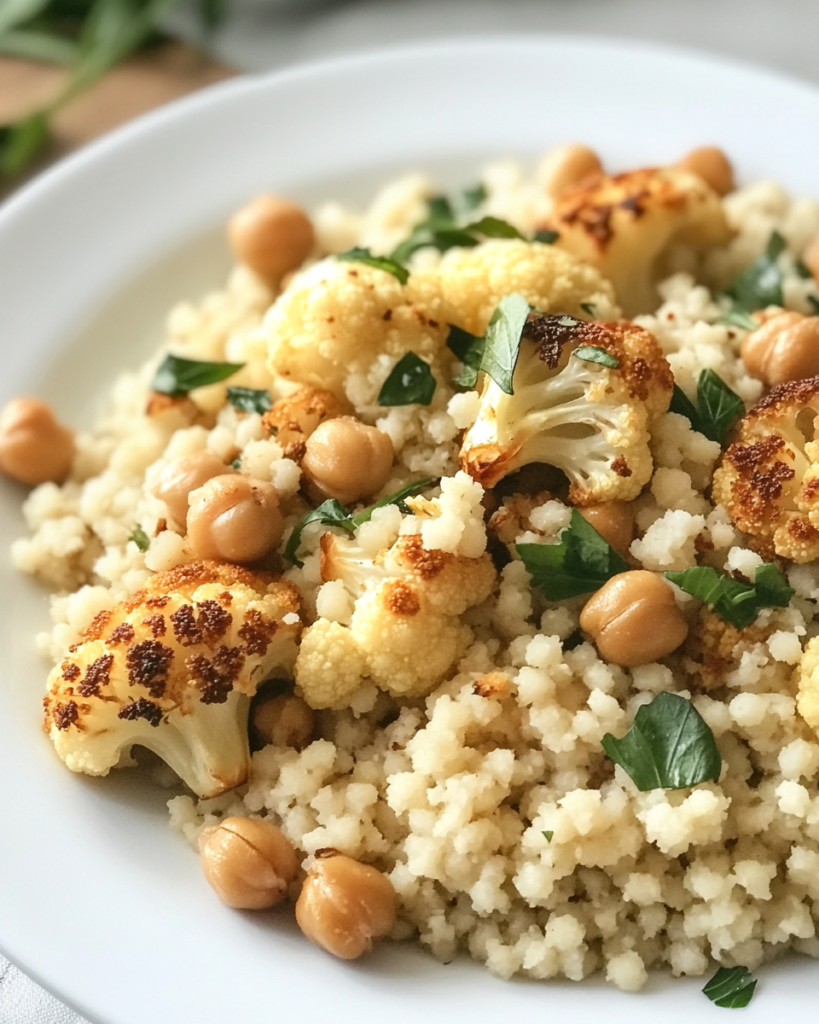
For the Coconut Couscous:
- 1 1/4 cups couscous
- 1 cup coconut milk (full fat for richness)
- 3/4 cup vegetable broth (or water)
- 1/2 teaspoon salt
- 1 tablespoon olive oil or vegan butter
- Zest of 1 lime
- Juice of 1/2 lime
Optional Toppings:
- Fresh cilantro or parsley, chopped
- Toasted coconut flakes
- A dollop of vegan yogurt or tahini sauce
- Pomegranate seeds for color and a touch of sweetness
Tips for Perfecting the Coconut Couscous
Getting the balance and texture right makes this dish shine. Here are some pro tips:
1. Don’t Rush the Roast
For truly flavorful and crisp cauliflower, give it space on the tray. Crowding causes steaming. Also, turning the florets halfway through helps even browning.
2. Use Full-Fat Coconut Milk
Light coconut milk works in a pinch, but full-fat gives the couscous a rich, creamy flavor that’s worth the few extra calories.
3. Adjust the Seasoning
Taste as you go. If your coconut milk is unsweetened but naturally sweet, you might want a touch more salt or lime to balance the flavors.
4. Fluff with a Fork
Avoid stirring the couscous with a spoon, which can make it mushy. A fork helps maintain a light, fluffy texture.
Variations to Try
This dish is extremely versatile. You can easily tweak it to suit your preferences or to use what you already have in the kitchen.
Swap the Veggies:
- Try roasted sweet potatoes, carrots, or brussels sprouts instead of or in addition to cauliflower.
- Add some sautéed kale or spinach at the end for extra greens.
Make It Protein-Rich:
- Use quinoa instead of couscous for a gluten-free, protein-rich base.
- Add some tofu cubes or tempeh seasoned and roasted with the chickpeas.
Go Grain-Free:
- Replace couscous with cauliflower rice for a low-carb option (skip roasting all of the cauliflower; reserve some for “rice”).
Spice It Up:
- Mix in harissa paste, sriracha, or a spoonful of chili garlic sauce for extra heat.
Add Sweetness:
- A handful of raisins, dried cranberries, or chopped dates mixed into the couscous can offer lovely contrast to the savory elements.
Frequently Asked Questions (FAQs)
1. Can I use a different grain instead of couscous?
Yes! If you prefer or need a gluten-free option, you can swap couscous with quinoa, millet, or even brown rice. Quinoa is especially great because it absorbs coconut milk well and adds extra protein.
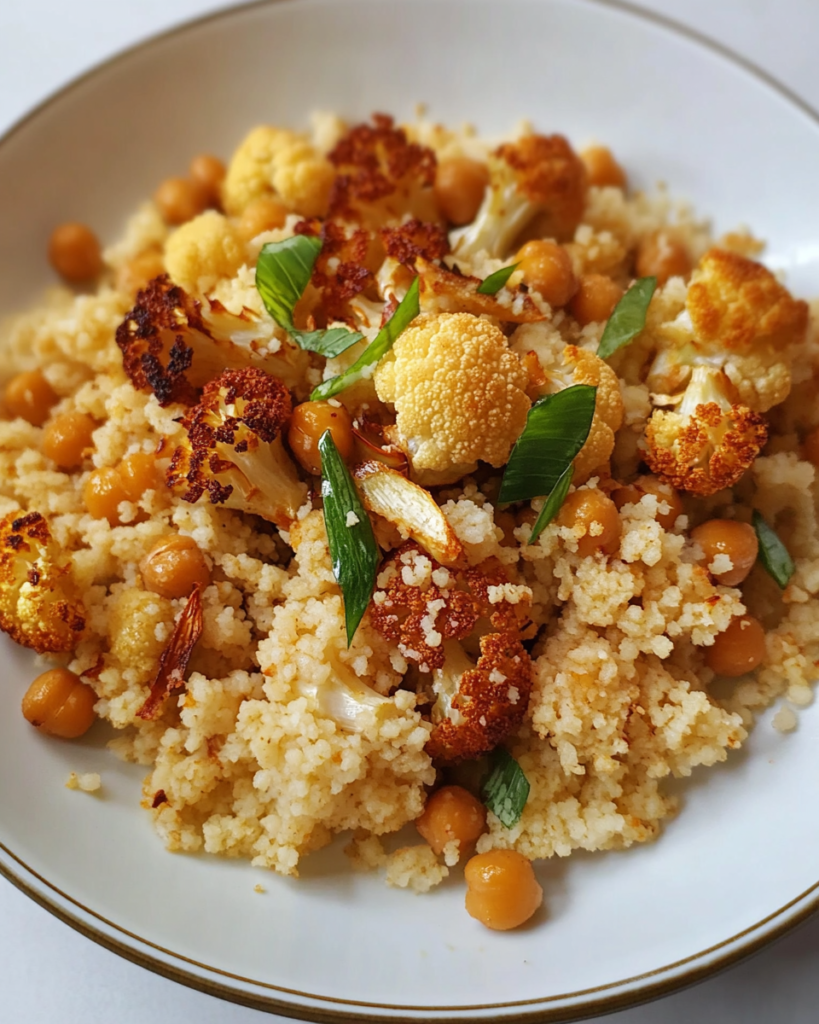
2. Is coconut milk necessary for the recipe?
Coconut milk is what gives this dish its unique flavor and creamy texture. However, if you’re not a fan of coconut or don’t have it on hand, you can substitute with unsweetened almond milk, oat milk, or just vegetable broth—though the flavor will be milder.
3. Can I make this dish ahead of time?
Absolutely. This recipe is meal-prep friendly. You can roast the cauliflower and chickpeas in advance and store them in the fridge for up to 4 days. The couscous also holds up well when stored separately in an airtight container.
4. How do I reheat leftover coconut couscous?
To reheat, simply place the couscous in a bowl, add a splash of water or coconut milk, and microwave for 1–2 minutes. You can also reheat it on the stove over low heat, stirring gently to fluff it up. Reheat roasted veggies in the oven or air fryer for best texture.
5. Is this recipe vegan and gluten-free?
The recipe is naturally vegan. However, traditional couscous is made from wheat, so it’s not gluten-free. To make it gluten-free, use alternatives like quinoa, cauliflower rice, or certified gluten-free couscous.
6. What can I serve with Coconut Couscous and Roasted Cauliflower?
This dish is complete on its own, but it pairs beautifully with:
- A fresh green salad
- A drizzle of tahini sauce or vegan yogurt
- Warm pita bread or flatbread
- Sides like hummus, tabbouleh, or pickled vegetables
7. How can I make this dish spicier?
If you enjoy heat, add a pinch of cayenne pepper, chili flakes, or a dash of hot sauce to the cauliflower spice mix. You can also top the finished dish with harissa or sriracha for an extra kick.
8. Can I freeze coconut couscous?
Yes, you can freeze both the couscous and the roasted vegetables. Just be aware that cauliflower may soften a bit when thawed. For best results, store in freezer-safe containers for up to 2 months and thaw overnight in the fridge before reheating.
9. Can I use canned coconut cream instead of coconut milk?
Yes, but you’ll want to dilute it slightly. Coconut cream is much thicker and richer. Use half coconut cream and half water or broth to mimic the consistency of coconut milk.
10. What’s the best way to store leftovers?
Store leftovers in separate airtight containers in the fridge. This helps maintain the texture of both the couscous and roasted veggies. They will stay fresh for up to 4 days.
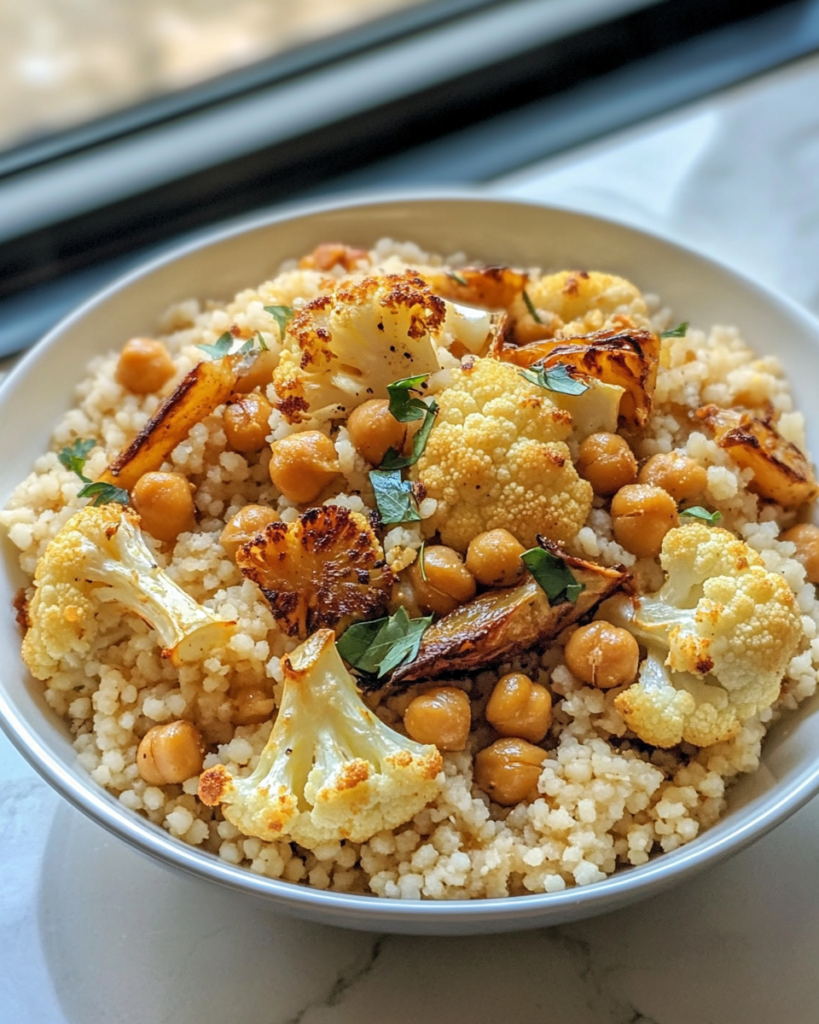
Step-by-Step Instructions
Let’s break the recipe down into easy-to-follow steps.
1. Preheat and Prep
Begin by preheating your oven to 425°F (220°C). Line a large baking sheet with parchment paper or foil for easy cleanup.
2. Season and Roast the Cauliflower and Chickpeas
In a large mixing bowl, toss the cauliflower florets and chickpeas with olive oil and all the listed spices: cumin, smoked paprika, turmeric, garlic powder, salt, and pepper. If you like a little kick, sprinkle in the cayenne.
Spread everything evenly on the prepared baking sheet. Make sure the florets are not overcrowded; this helps them roast instead of steam.
Roast for 25–30 minutes, stirring halfway through, until the cauliflower is golden and crispy on the edges and the chickpeas are lightly browned.
3. Make the Coconut Couscous
While the vegetables roast, focus on the couscous.
In a medium saucepan, bring coconut milk, vegetable broth, salt, and olive oil (or vegan butter) to a gentle boil.
Once it’s boiling, remove from heat and stir in the dry couscous. Cover with a lid and let it sit for 5 minutes. During this time, the couscous will absorb all the liquid.
After 5 minutes, fluff the couscous with a fork to break up any clumps. Then add lime zest and lime juice. Stir gently to incorporate.
4. Assemble and Garnish
Now comes the fun part—putting it all together!
Spoon a generous bed of coconut couscous onto a plate or into a bowl. Top with the roasted cauliflower and chickpeas.
Garnish with fresh herbs like cilantro or parsley, add a few toasted coconut flakes for crunch, and a spoonful of tahini or vegan yogurt if you like.
Serve immediately while everything is warm and aromatic.
Storage and Conservation
One of the best things about this dish is how well it keeps. Here’s how to store leftovers:
In the Fridge:
- Store in an airtight container for up to 4 days.
- Keep the couscous and roasted vegetables separate if possible for best texture when reheating.
In the Freezer:
- The couscous freezes well, though the texture of roasted cauliflower may soften slightly.
- Store in freezer-safe containers for up to 2 months.
- Thaw in the fridge overnight before reheating.
Reheating:
- Warm couscous gently in a microwave with a splash of water or coconut milk.
- Reheat cauliflower and chickpeas in the oven at 350°F for 10–15 minutes to revive some crispness.
Serving Suggestions for Coconut Couscous Roasted Cauliflower
This dish works as both a main or a hearty side. Here are some serving ideas to inspire you:
- Main Dish: Serve as-is for a fulfilling plant-based meal.
- With a Salad: Pair with a tangy cucumber-tomato salad or arugula with lemon vinaigrette.
- Wrap It Up: Spoon into a warm flatbread or pita with greens and sauce for a delicious wrap.
- Party Platter: Make a big batch and serve buffet-style with other Middle Eastern or Mediterranean dishes like hummus, tabbouleh, and baba ganoush.
For a more elegant presentation, use a ring mold to shape the couscous on each plate and arrange the roasted veggies artistically around it.
Final Thoughts
Coconut Couscous with Roasted Cauliflower & Chickpeas is more than just a meal—it’s a celebration of texture, spice, and vibrant flavor. The coconut-infused couscous adds a velvety backdrop to the smoky cauliflower and chickpeas, while lime zest brightens the entire dish with a fresh citrusy lift.
This recipe shines because it’s flexible, nutritious, and comforting. It can be dressed up for guests or kept simple for a weekday lunch. Plus, it’s budget-friendly and easy to scale up or down.
Whether you’re cooking for yourself, your family, or entertaining friends, this dish will leave everyone satisfied and asking for seconds.
So next time you’re wondering what to do with that head of cauliflower or can of chickpeas in your pantry—think coconut, couscous, and a whole lot of delicious.

